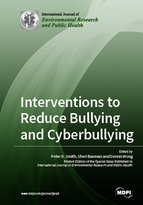Interventions to Reduce Bullying and Cyberbullying
A special issue of International Journal of Environmental Research and Public Health (ISSN 1660-4601). This special issue belongs to the section "Health Behavior, Chronic Disease and Health Promotion".
Deadline for manuscript submissions: closed (31 December 2018) | Viewed by 118370
Special Issue Editors
Interests: school bullying; cyberbullying; prevention; culture, play; grandparenting
Special Issues, Collections and Topics in MDPI journals
Interests: bullying; cyberbullying; cyber aggression; social media; teacher responses to bullying
Special Issues, Collections and Topics in MDPI journals
Special Issue Information
Dear Colleagues,
We are organizing a Special Issue on Interventions to Reduce Bullying and Cyberbullying in the International Journal of Environmental Research and Public Health. The venue is a peer-reviewed, scientific journal that publishes articles and communications in the interdisciplinary area of environmental health sciences and public health. For detailed information about the journal, we refer you to https://www.mdpi.com/journal/ijerph.
Over recent decades, bullying, and the more recent version of cyberbullying, have come to be recognized as important social and public health issues, generating an increasing volume of publications. It has been understood as a global, international issue, as evidenced in the UNESCO 2017 report on School Violence and Bullying: School Status Report. However, bullying is not only a school phenomenon. It can occur in many contexts such as families, residential homes, colleges, the workplace, prisons, and the armed forces. Wherever it occurs, it can have harmful and pernicious effects, for all involved including bystanders. For the victims especially, outcomes can include loss of self-esteem, depression, health problems, and reduced academic or work performance. Perpetrators, if unchallenged, can learn that this kind of abusive behavior can be carried out with impunity and continue on a pathway of antisocial behavior.
From the origins of research on bullying, there have also been attempts to intervene, noticeably in school settings. These are having some success. An important phase in current research is to document successes and failures in anti-bullying interventions, and relate these to our rapidly growing knowledge base.
This Special Issue aims to document interventions against bullying, including cyberbullying, in schools or in other contexts. Besides being open to different contexts, we also welcome contributions from across the globe, including non-western countries. Failures are important and can be learnt from, as well as successes. The listed keywords suggest a few of many possibilities.
Prof. Dr. Peter Smith
Prof. Dr. Sheri Bauman
Prof. Dr. Dennis Wong
Guest Editors
Manuscript Submission Information
Manuscripts should be submitted online at www.mdpi.com by registering and logging in to this website. Once you are registered, click here to go to the submission form. Manuscripts can be submitted until the deadline. All submissions that pass pre-check are peer-reviewed. Accepted papers will be published continuously in the journal (as soon as accepted) and will be listed together on the special issue website. Research articles, review articles as well as short communications are invited. For planned papers, a title and short abstract (about 100 words) can be sent to the Editorial Office for announcement on this website.
Submitted manuscripts should not have been published previously, nor be under consideration for publication elsewhere (except conference proceedings papers). All manuscripts are thoroughly refereed through a single-blind peer-review process. A guide for authors and other relevant information for submission of manuscripts is available on the Instructions for Authors page. International Journal of Environmental Research and Public Health is an international peer-reviewed open access monthly journal published by MDPI.
Please visit the Instructions for Authors page before submitting a manuscript. The Article Processing Charge (APC) for publication in this open access journal is 2500 CHF (Swiss Francs). Submitted papers should be well formatted and use good English. Authors may use MDPI's English editing service prior to publication or during author revisions.
Keywords
- Bullying
- Cyberbullying
- Abuse
- Harassment
- Interventions
- Schools
- Colleges
- Families
- Residential homes
- Workplace
- Prisons
- Armed forces
- Resources
- Victims
- Perpetrators
- Bullies
- Bystanders








